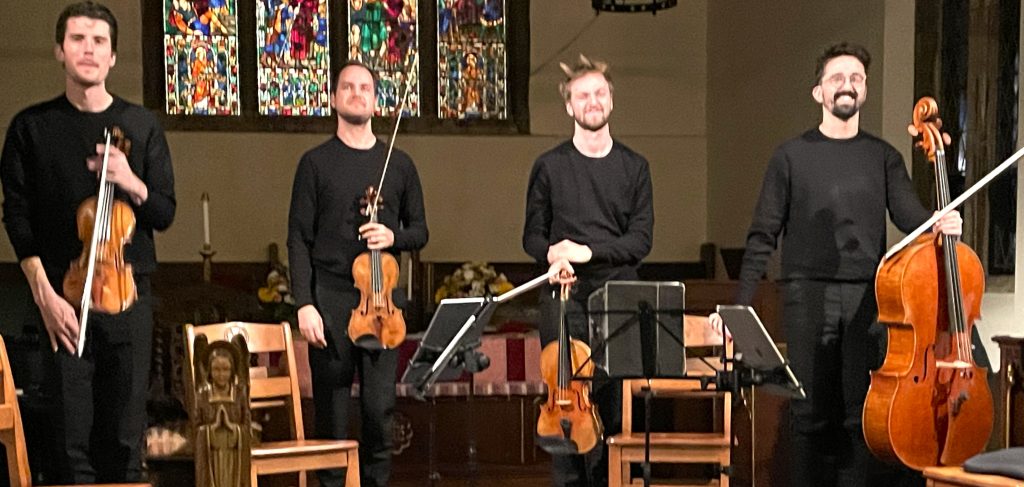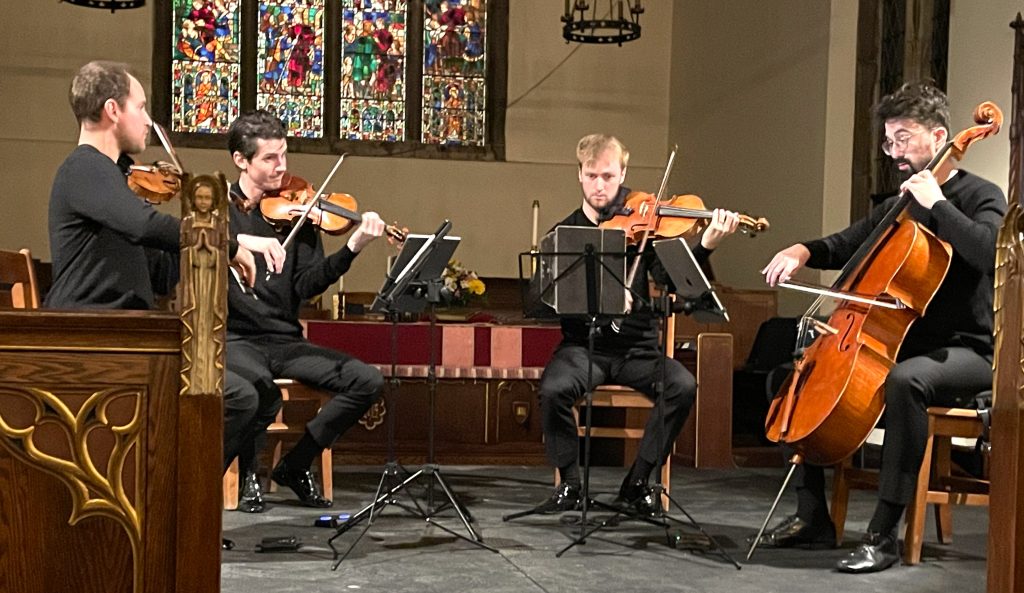
by Kevin T McEneaney
Agate String Quartet, four players from France, are currently on a tour of the Once-United States. They performed in the acoustically favorable All Saints Chapel, opening with W.A. Mozart’s String Quartet in D major, K. 575 (or sometimes cited as No. 21). This 1790 quartet was his first quartet written for King Friedrich Whihelm in Berlin. Since the King played the violoncello, he wanted that instrument in the quartet. Mozart played piano and viola and was not really a fan of the lower register of the violoncello. Constanze was sick, and Mozart did not feel well himself. Nevertheless, he composed a sprightly, cheerful quartet thematically similar to Franz Haydn’s String Quartet, Op. 20 in G minor, a humorous court piece celebrating the four stages of a court banquet.
Anticipation bubbles with delight in the opening Allegretto as chatting guests arrive, the lead violin, played with high zest by Adrien Jurkovic, dramatizes high-pitched, screeching tidbits of gossip. The delightful viola, played with modest grace by Raphael Pagnon, repeats the expansive main theme of traveling gossip. In the A major Andante, the audience is chatting and eating at tables, then the cello, representing the voice of the king, enters the convivial assembly. The lively Menuetto dramatizes court dancing with sprightly rhythms as second violinist Thomas Descamps leaned excitedly into the rhythm. The concluding Allegretto celebrates the dancing of the king with elegance, wherein cellist Simon Iachemet took the lead to shine with lower, more grave and gracious notes from the cello.
They next performed The Last Flight (2004) by Ukrainian composer Anna Korsun. This was an eerie, spooky work with a post-modern texture. It was about a seventeenth-century legend about a rich despot who had two wives and two mistresses chained in the castle basement. He kills one of his wives. I took this as an allegory for the current war between Russia and Ukraine, Ukraine being the wife who is being tortured and may die next year. The high-pitched strings were laden with terror. It was an arresting and effective lament.

String Quartet in F (1902) by Maurice Ravel was acclaimed by French music critics as his first masterpiece that entered the debate on the use of cyclicism, which the Germans had condemned as antique retrograde. Ravel employed cyclicism as a motif of memory, not as a repeating refrain, which is a traditional refrain in Celtic folk music. Ravel’s energetic use of cyclicism remains jarring and not rote cliché. The opening pizzicato of the second movement is shocking, amusing, and thrilling! The third movement brims slowly with nostalgia. Ravel’s erratic cyclicism is especially effective in the last movement, Vif et Agité, where the audience feels that they have experienced a roller-coaster ride through the history of music and personal recollections….
I have heard this quartet played before, yet here, there was a very French accent of gaiety and national pride that gave this performance a subtle exactitude and intense ambiance found only in France!
